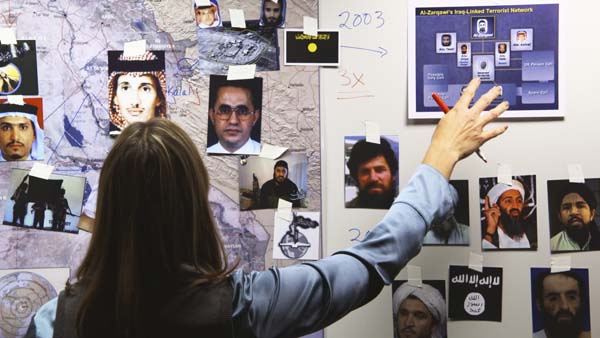 Long before either World Trade Center attack, there was a group of women at the CIA who were tracking Osama Bin-Laden and first identified that he even had a secret terror network called alQaeda.
Long before either World Trade Center attack, there was a group of women at the CIA who were tracking Osama Bin-Laden and first identified that he even had a secret terror network called alQaeda.
“Women make fantastic analysts,” says one of them, Nada Bakos, in the fascinating documentary about the years long search for bin-Laden “Manhunt” (HBO, 8 p.m.) that premieres tonight — on the second anniversary of his killing.
“We have patience, perseverance,” Bakos continues. “And we’re not always looking for the sexy payoff immediately.”
Indeed, the network of women who tracked the operation had to convince their superiors that what they were doing was important. Instead they were told they were spending too much time on the terrorist.
Even after the first World Trade Center bombing, the one on an embassy in Kenya, the attack on the U.S.S. Cole, the group had a tough time getting attention to their cause, according to the film by Greg Baker.
And through 2001, there wasn’t just a single memo that the White House ignored on bin Laden’s determination to attack the U.S.; there were several. Enough, that when they are all taped to a glass wall for effect, it almost covers it.
Even so, after 9/11, the group was scapegoated, and constantly asked: Why didn’t you connect the dots? Well, there were so many dots, one agent says, the page would be black.
Even after “Zero Dark Thirty” and other theatrical representations of bin Laden’s end, “Manhunt” is an important look at how methodically the government went after him, using the biggest secret force in the country’s history, thereby militarizing the intelligence arm.
Marty Martin, who headed the CIA’s operations against al-Qaeda, talks for the first time in the film as it shifts to depict the intense rounding up of suspect and their “enhanced interrogation” at “black site” prisons. The man who led Counter Terrorism says the interrogation techniques were “wimpy stuff,” though an FBI agent says no good information ever came from the practices which were generally regarded as torture.
Lest you think these stories are old hat, a number of under told stories come to light, such as one that involves a man who was being courted as a possible source, who came to CIA headquarters on the Pakistan border and blew it up, killing several.
The killing of bin Laden itself gets less time, but with so much to tell about the build up, it’s understandable. The film, as taut and riveting as any thriller, is built visually around a visual flow chart of connections — like the one Carrie constructed in her dining room in “Homeland.” It keeps the historical figures straight even as it reflects how their own work was done.
Barker, who previously made “Sergio” for HBO, spent many years with PBS’ “Frontline” and that quality of research and presentation are evident throughout “Manhunt.”